Chris Hardwick's Blog, page 276
July 19, 2024
The Biggest Questions We Have After THE BOYS Season Four Finale
Homelander is the ruler of America (with Sage’s guidance) and we are all very afraid for the Boys. The season four finale left things in a very chaotic place with most of our favorite collective in custody, quite a few people MIA, and some appearances and teases that will give us lots to speculate on as we wait for season five. Here’s all the biggest questions we have after The Boys season four finale.
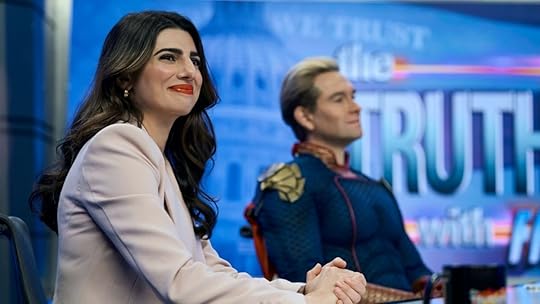 Prime VideoWhere Is A-Train and Will He Return to The Boys in Season Five?
Prime VideoWhere Is A-Train and Will He Return to The Boys in Season Five?Let’s start off with one of the most obvious questions following The Boys season four finale. Many people thought that A-Train would die in the season finale after he revealed the truth to the Deep and Black Noir. But there was far too much going on with the Robert Singer assassination plan and Homelander’s spiraling for anyone to even check on him. A-Train took off to parts unknown along with his entire family and did not appear in the season four finale. Maybe he took Ashely’s suggestion and went to Florence, Italy. No matter where he is, he will certainly have to keep a very, very low profile. The wrong person recognizing him and/or recording him could lead to disaster.
It’s highly likely that A-Train will return in season five. Annie is essentially on her own, and she will need supe help to be able to save the Boys and take down Homelander for good.
Will Queen Maeve Get Her Powers Back and Return to Fight Homelander and Soldier Boy Again?At the end of season three, Queen Maeve took Homelander on and gave the Boys a chance to subdue Soldier Boy. She made the ultimate sacrifice by tackling Soldier Boy out of a window so his blast wouldn’t kill everyone. It left her without her powers, but it also gave her the perfect way to leave Vought forever. Outside of Ashley (and her assistant Ashely, who is now dead), no one else at Vought knows that Maeve is still alive. She’s living the good life with her girlfriend on a farm, but all the chaos in the world could lead to her suiting up again. She could easily take Compound V to regain her powers, like Kimiko did, and help A-Train and Annie/Starlight in this final push to take down Homelander and Vought. But will she? We’ll have to wait and see what the answer to this The Boys season four question is when The Boys returns to our screens once more.
What Happened to Ashely After Taking Compound V in The Boys Season Finale? Is Ashely a Supe Now?Speaking of people taking Compound V, the latest person to inject themselves with the drug was Ashely. After Homelander gives the Deep, Black Noir, and Firecracker a list of Vought employees to kill, they realize that Ashley is the one who knows the most dirt about them. She overhears this and takes off running to Homelander’s apartment. Once there, she injects herself with Compound V, and a grotesque reaction appears to take place. We see her infamous wig fall off, but we never see what she looks like nor what powers she has now. It’s not even clear if she survives the injection or how “human” she is, if alive. We will have to wait for answers to questions about Ashely’s fate in The Boys season five.
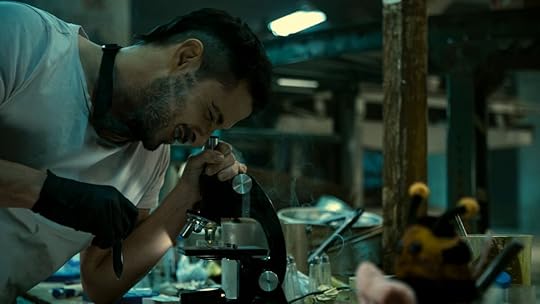 Prime VideoWhat Did Cate Whisper to Frenchie?
Prime VideoWhat Did Cate Whisper to Frenchie?After the media frames the Boys and Robert Singer for Victoria Neuman’s death, they split up with fake passports to live their lives. Unfortunately, Homelander and Sage are on the case, using police forces and supes to hunt them down. Gen V’s Cate Dunlap and Sam Riordan are the duo who catch Frenchie and Kimiko. Cate whispers something in Frenchie’s ear that causes him to go with her without a fight. This upsets Kimiko greatly to the point that she speaks for the first time, yelling “no” repeatedly. It is a sad ending for the pair, who finally kissed and were planning to make a life together.
Will Kimiko Continue to Speak in The Boys Season Five?A traumatic event took Kimiko’s voice away as a child and now another one restored her voice. We aren’t sure what will happen to Kimiko but we hope that she will continue to speak in season five. She deserves all the happiness in the world.
Where Did Ryan Go, and Will He Return to Homelander?Butcher and Grace Mallory tried to convince Ryan to stay in a government bunker and train to kill his father Homelander. It’s a lot to put on a mostly innocent kid, especially one who just found out that Homelander raped his mother Becca and killed an entire airplane full of people. (So much to digest.) Ryan wants to go, but Grace tries to keep him there. He pushes her into a wall and snaps her neck before leaving the facility as a horrified Butcher looks on. We don’t see Ryan return to Vought Tower, so his whereabouts are unknown at this time. Where he went is absolutely a question on our minds after The Boys‘ season four finale.
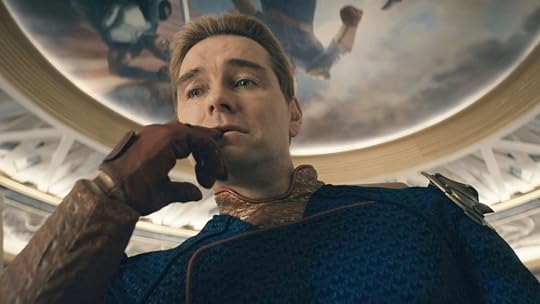 Prime VideoWill Sameer Find Zoe at the Red River Institute?
Prime VideoWill Sameer Find Zoe at the Red River Institute? Now that Victoria is dead, her poor daughter Zoe is a resident at Red River Institute. It is the one place that her mother didn’t want her to be. But it is rather strange that she’s there. Her father Sameer isn’t dead. He left the facility where Butcher was holding him hostage with one less leg, but still alive. Surely he’s gotten wind of Victoria’s death and will seek out his daughter, right?
Where the Hell Is Stan Edgar?!Speaking of people missing in action, we haven’t seen Stan Edgar since all that mess at the farm. Victoria allowed him to leave instead of going back to prison, but where did he go? Will he look for Zoe? And what kind of revenge will he plot on the Boys for killing his daughter? We have so many Stan questions, but we shall wait patiently to see how Stan fits into season five.
Who Is the Telekinetic Supe That Attacked Annie and Hughie?At the end of the finale, we see all the Boys come across supes working for Homelander. There’s one person who isn’t as familiar. She’s rocking a shaved head and sweatpants in the style of Stranger Things’ Hawkins Lab subjects. Quite a few fans won’t remember her because, well, we’ve barely seen her in this series. The supe that attacks Hughie and Annie is telekinetic supe Cindy from season two. She was a former patient at Sage Grove Center, a psychiatric hospital owned by Vought to experiment on humans.
After things go awry during a visit from Frenchie, Kimiko, and MM, Cindy escapes and walks off in the streets. Outside of a TV appearance that says she’s wanted for several crimes, this is our first time really seeing Cindy again. We assume Homelander has forgiven her for her crimes and will include her in his supe inner circle. Someone has to replace A-Train, I guess…
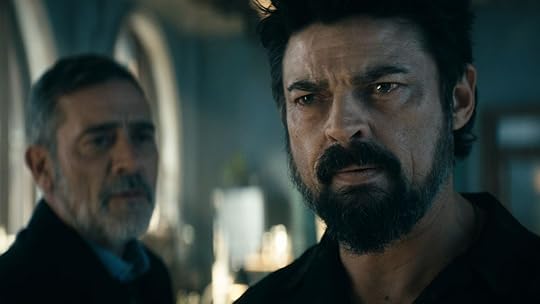 Jasper Savage/The BoysWhere Is Butcher Going, and Will He Release the Virus?
Jasper Savage/The BoysWhere Is Butcher Going, and Will He Release the Virus?This is perhaps the biggest question in The Boys universe right now. Butcher appears to be alive and well after letting that parasitic dark side to take over. He kills Victoria and goes off on his own to some unknown place. He has the virus in hand, but how he is going to get enough of it to cause a supe genocide? Where is he going? You never know what he’s up to but it sure doesn’t look like he’s gonna die.
What Will Annie Do Without the Boys, and Where Will She Go Next?Poor Annie is on her own. She escaped capture and flew off, finally regaining her powers at the best possible moment. But she’s still a wanted woman with a very recognizable face. She cannot go home to her mom nor back to any familiar place. Perhaps she will try to find A-Train or Queen Maeve so they can help her break the Boys out of wherever they are being held.
Does Anyone Work at Vought Anymore? What’s the Status of the Company?Homelander’s takeover plan included killing any Vought employee who has dirt on them. That’s pretty much every person working at the company. It looks like they marked off most of the names on their sheet, so it begs the question who even works at Vought anymore on The Boys? What is the status of the company with Ashely officially gone (or dead) and the supes busy running America? The Boys season five could answer this question quickly and reveal that Vought is no longer a conglomerate to be reckoned with.
 Jasper Savage/Prime VideoWhat Does Sage Really Want?
Jasper Savage/Prime VideoWhat Does Sage Really Want? Sage is making the world burn because 1) she hates humans and 2) she can. It’s pretty clear she’s using everyone, including Homelander, for her own entertainment. But does Sage want something else out of the deal? Does she have an ulterior motive, or is she just chaotic for no reason? These are questions that The Boys may answer in season five, but Sage herself has some thoughts.
“I think she is processing so much information and so many possibilities all the time,” Susan Heyward, who plays Sage, told us in a recent interview. “…I think she needs something to make her excited, something to give her a reason to live. She has the opportunity to create chaos and a universe that was unlikely. I think it gives her a thrill to help her feel alive.”
Now that’s diabolical. It will probably be a while before these questions get answers but in the meantime, we can watch The Boys season four all over again (and again).
The post The Biggest Questions We Have After THE BOYS Season Four Finale appeared first on Nerdist.
Are Those Infinity Stones on Cassandra Nova’s Sling Ring From DEADPOOL & WOLVERINE?
After years of speculating, in 2022, Marvel Studios confirmed that Deadpool would officially join the MCU for a third installment of the R-rated comic book franchise at the start of Phase Six, Deadpool & Wolverine. This would mark the first official character of the Fox X-Men universe joining the MCU (although Patrick Stewart as a variant Professor X in Doctor Strange in the Multiverse of Madness kinda counts too, we suppose).
In a post on his Instagram story, Ryan Reynolds also gave us a closer look at Cassandra Nova’s sling ring. It looks like two infinity stones, the Time Stone and the Reality Stone, might be appended to it. We guess we’ll have to wait and see just how that works.
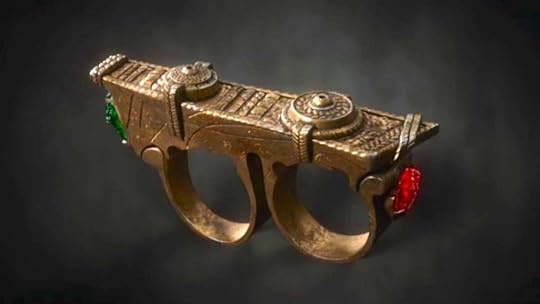 Marvel Studios
Marvel Studios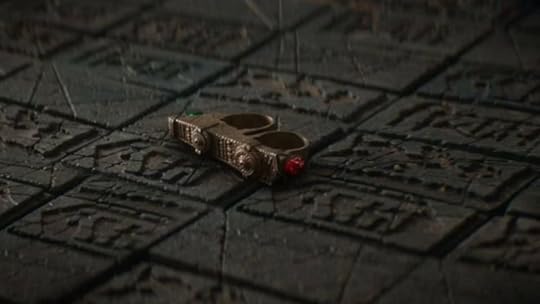 Marvel Studios
Marvel StudiosDeadpool & Wolverine‘s latest teaser trailer brings yet another new Deadpool into the mix. This time it’s Lady Deadpool.
We can’t wait to find out who will be playing this red-clad gal. Additionally, Cowboy Deadpool also makes an appearance.
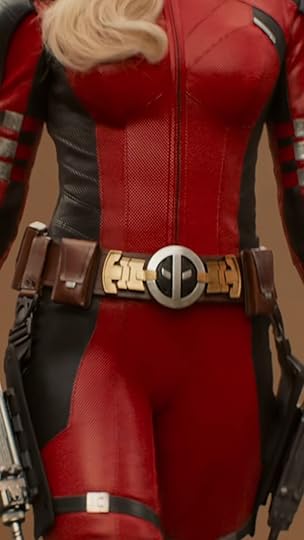 Marvel Studios
Marvel Studios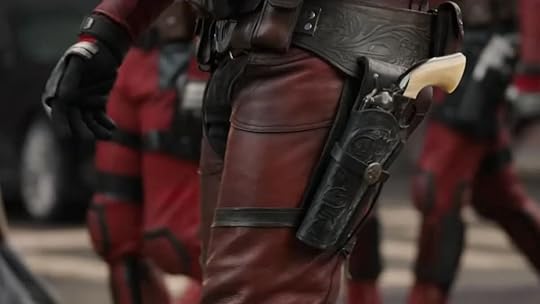 Marvel Studios
Marvel StudiosHere is everything we know so far about Deadpool & Wolverine.
Title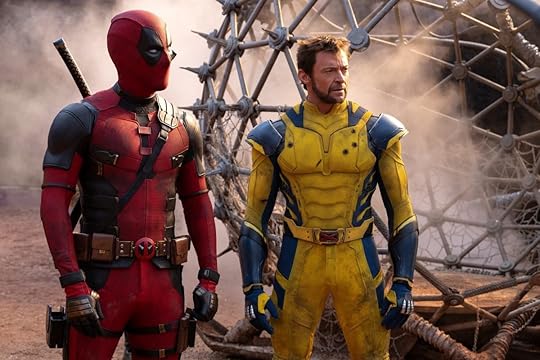 Marvel Studios
Marvel StudiosThanks to a Super Bowl trailer (check it out below!), we know that this film, formerly called Deadpool 3, is actually Deadpool & Wolverine.
Deadpool & Wolverine‘s PlotThe plot of Deadpool & Wolverine remains a mystery. All we know is that Hugh Jackman is returning as Wolverine, and that it takes place before the feral X-Man’s death in Logan. In fact, Jackman has confirmed that time travel will be involved in the threequel in a big way.
While originally, Deadpool & Wolverine was called Deadpool 3, director Shawn Levy wants to make sure fans understand that the title change is not just cosmetic. Levy notes to Screen Rant:
As far as crafting the Deadpool & Wolverine story, I just felt privileged every day because you’re talking about two massive movie stars in their most iconic roles. It also gave me an opportunity. It’s the third Deadpool movie, but it’s not Deadpool 3. It’s a different thing that’s very much Deadpool and Wolverine. And it’s not trying to copycat anything from the first two movies. They were awesome, but this is a two-hander character adventure.
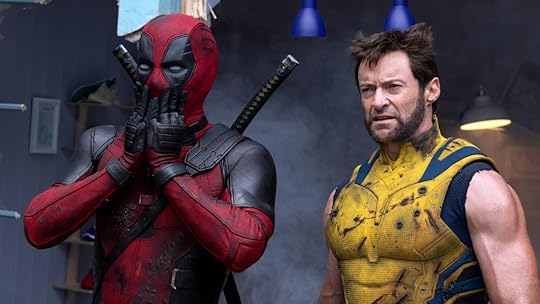 Marvel Studios
Marvel StudiosAs most folks know by now, Deadpool’s third solo film will reunite him with his X-Men Origins: Wolverine co-star. Deadpool and Wolverine will work together, although they have made it very clear that these two characters “hate each other.” It will not be a love-fest in this story. But the fact that Deadpool & Wolverine is smack in the middle of the Multiverse Saga should give us all a clue as to what’s going to go down, and probable multiversal shenanigans will ensue.
Dogpool, of course, will also star.
Make sure to follow him on Instagram.
We also now know what Deadpool & Wolverine‘s new official logo looks like thanks to a fun poster.
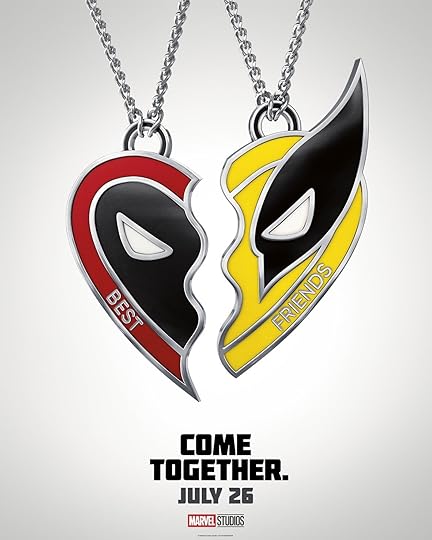 Marvel Studios
Marvel StudiosDeadpool & Wolverine will, of course, be the first R-rated movie in the MCU. And that means it’s not pulling any punches. In fact, its latest official synopsis drops two F-bombs. Let’s take a look:
Deadpool & Wolverine‘s CastMarvel Studios presents their most significant mistake to date—Deadpool & Wolverine. A listless Wade Wilson toils away in civilian life. His days as the morally flexible mercenary, Deadpool, behind him. When his homeworld faces an existential threat, Wade must reluctantly suit-up again with an even more reluctantlier… reluctanter? Reluctantest? He must convince a reluctant Wolverine to—Fuck. Synopses are so fucking stupid.
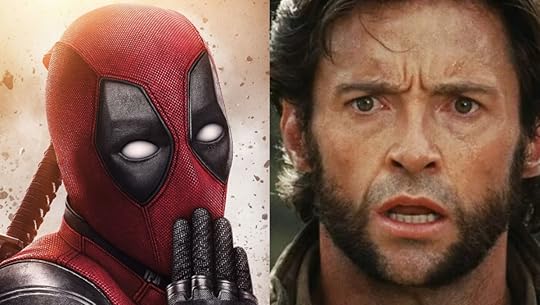 20th Century Studios
20th Century StudiosWe know Hugh Jackman will return, along with the very obvious Ryan Reynolds. Here’s who else we know about: Karan Soni, cab driver Dopinder, Leslie Uggams, Emma Corrin, and Matthew Macfadyen. In exciting news, Morena Baccarin and Stefan Kapicic are reprising their roles as Vanessa and Colossus in Deadpool & Wolverine. So are Rob Delaney’s Peter, Brianna Hildebrand (Negasonic Teenage Warhead), and Shioli Kutsuna (Yukio). Jennifer Garner’s Elektra from the 2003 Daredevil Marvel Fox movie is also reported to reprise her role in this MCU film.
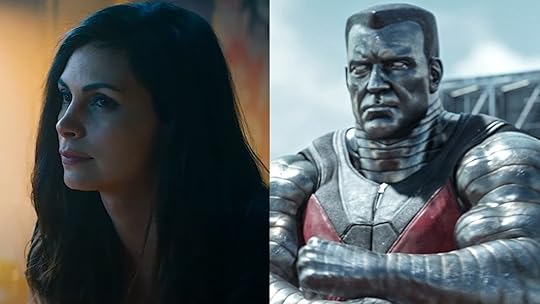 20th Century StudiosBehind the Scenes
20th Century StudiosBehind the Scenes Deadpool & Wolverine‘s director for this third outing will be Shawn Levy, most recently known for his work on Stranger Things. This would be a reunion for Levy and Reynolds, as the pair previously worked together on the movie Free Guy. Levy is also known for the time travel movie The Adam Project.
On the writing side of things are Wendy Molyneux and Lizzie Molyneux-Logelin, writers for the popular animated series Bob’s Burgers. The writers for the first two Deadpool films, Rhett Reese and Paul Wernick, are also contributing to movie number three’s screenplay, as is Ryan Reynolds himself.
Deadpool & Wolverine Release Date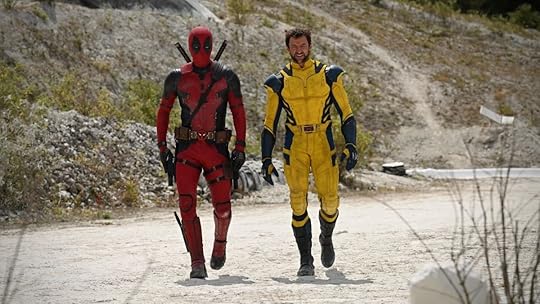 Marvel Studios
Marvel StudiosDeadpool & Wolverine will arrive on July 26, 2024.
Originally published on January 4, 2023.
.youtube-embed{padding-bottom:56.25%!important;position:relative;overflow:hidden}.youtube-embed a,.youtube-embed iframe{display:block;width:100%;height:100%;position:absolute}.youtube-embed iframe{border:0}.youtube-embed img.youtube-cover{-o-object-fit:cover;object-fit:cover;height:100%;width:100%;cursor:pointer}.youtube-embed img.play-button{width:66px;position:absolute;left:46%;top:0;bottom:0;margin:auto;cursor:pointer}@media only screen and (max-width:499px){.youtube-embed img.play-button{left:45%;width:60px}}@media only screen and (max-width:425px){.youtube-embed img.play-button{left:44%;width:60px}}@media only screen and (max-width:375px){.youtube-embed img.play-button{left:43%;width:56px}}@media only screen and (max-width:345px){.youtube-embed img.play-button{left:42%;width:50px}}.youtube-embed .progressive-img{-webkit-filter:blur(10px);filter:blur(10px)}.youtube-embed .progressive-img.loaded{-webkit-filter:none;filter:none;-webkit-transition:-webkit-filter 1s ease-out;transition:-webkit-filter 1s ease-out;-o-transition:filter 1s ease-out;-moz-transition:filter 1s ease-out;transition:filter 1s ease-out;transition:filter 1s ease-out,-webkit-filter 1s ease-out}.youtube-embed .kskdDiv{display:none!important}The post Are Those Infinity Stones on Cassandra Nova’s Sling Ring From DEADPOOL & WOLVERINE? appeared first on Nerdist.
July 18, 2024
ARCANE Season One Coming to Blu-ray in Standard and 4K Ultra HD Deluxe Sets
In 2021, the animated series Arcane, based on the popular video game League of Legends, debuted on Netflix, and fans and critics went wild. As is the case with many series that debuted on a streaming service, it was denied a physical media release. Until now, that is. The series will finally get a definitive, limited-run Collector’s Edition, 4K UHD, and a Standard Edition SteelBook Editions. There’s also a Blu-Ray Standard Edition, and on Digital Download-to-Own. All editions are currently available for preorder.
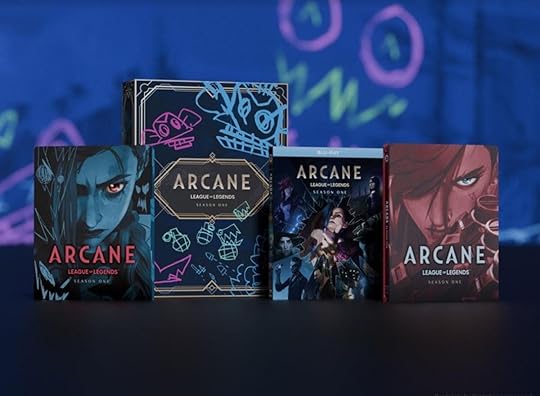 GKIDS/Riot Games
GKIDS/Riot GamesSo what can Arcane fans expect? The limited-run Collector’s Edition is presented in a rigid clamshell box featuring original artwork. It contains all nine episodes presented in 4K resolution, mastered in Dolby Vision HDR. The edition also contains all episodes on standard Blu-ray discs. In addition to the full series, the set also has brand new exclusives to the Collector’s Edition.
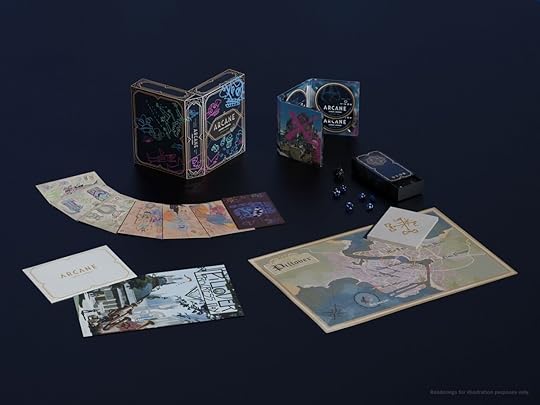 Riot Games/GKIDS
Riot Games/GKIDSThis includes a double-sided poster featuring artwork from Piltover’s “Progress Day.” It features one side defaced by Jinx, six art cards with Powder’s illustrations, Caitlyn Kiramann’s map of Piltover, and an expansive dice set containing a Hexcore-inspired d20 die, seven liquid core resin dice inspired by Hex crystals, a protective pouch and decorative dice box. This set is limited to 6500 copies for North America.
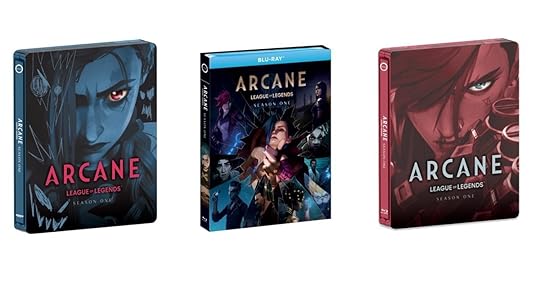 GKIDS/Riot Games
GKIDS/Riot GamesThe 4K UHD SteelBook features a stunning Jinx-themed outer package, containing the full nine-episode series presented across three 4K UHD discs. There’s also an additional Blu-ray disc containing over three hours of bonus features. The Standard SteelBook edition arrives in a Vi-themed outer package, containing the same nine-episode series and the same accompanying bonus features across three discs.
Click To View Gallery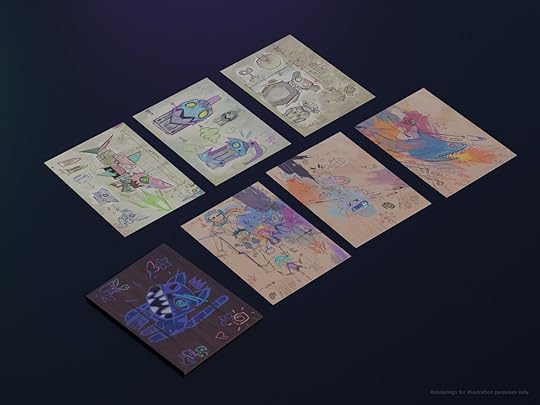 GKIDS/Riot Games
GKIDS/Riot Games 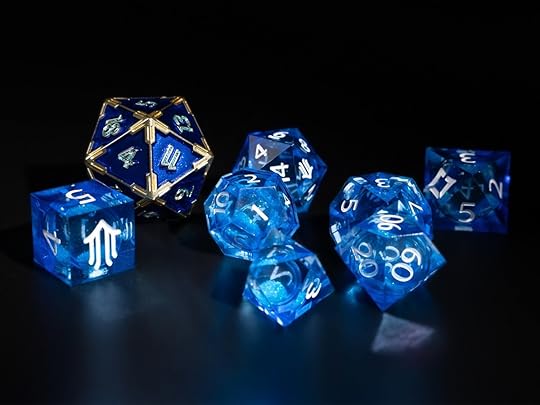 Riot Games/GKIDS
Riot Games/GKIDS 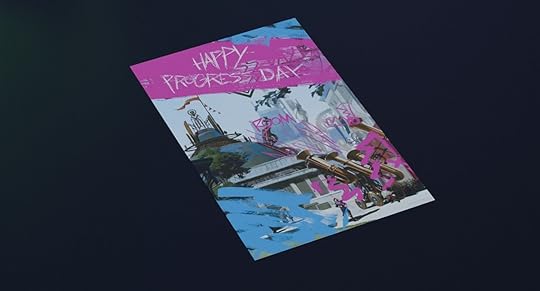 GKIDS/Riot Games
GKIDS/Riot Games 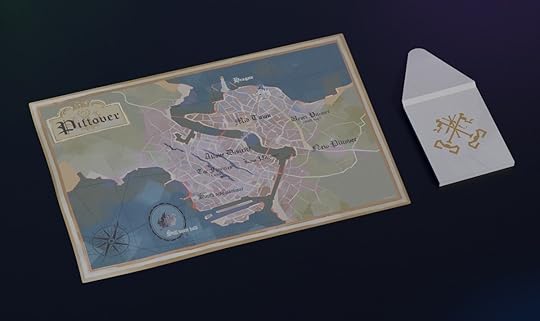 Riot Games/GKIDS
Riot Games/GKIDS The Standard Blu-ray edition presents the series and bonus features across three Blu-ray discs. Both versions of the SteelBook edition and the standard Blu-ray edition drop on October 8, 2024 from Shout! Studios. Bonus features on all physical editions include exclusive conversations with key creative talent and writers. Also, numerous scene breakdowns from the animation staff at studio Fortiche, “making-of” videos, and more. Arcane will be available in North America starting September 24, 2024 on digital download-to-own platforms.
The post ARCANE Season One Coming to Blu-ray in Standard and 4K Ultra HD Deluxe Sets appeared first on Nerdist.
The 10 Greatest Green Lantern Comic Book Runs, Ranked
“In Brightest Day, in Blackest Night. No evil shall escape my sight.” The Green Lantern, the protector of Space Sector 2814, has said that oath for decades. As a character, Green Lantern has been a mainstay of DC Comics since 1940, with many different heroes wielding the emerald Power Ring. Soon, DC Studios will tackle a Green Lantern TV series for HBO, simply called Lanterns. So now is the perfect time to take a deep dive into the many decades of Green Lantern comics from DC. And to help you choose, we present to you the ten greatest Green Lantern comic book runs of all time.
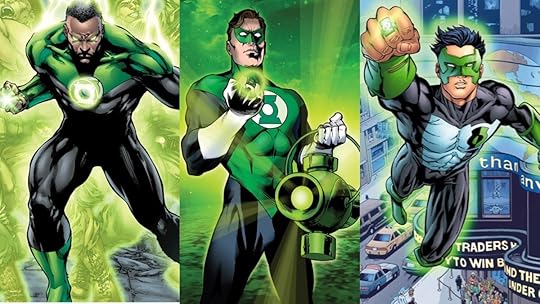 DC Comics10. The Green Lantern by Grant Morrison and Liam Sharp
DC Comics10. The Green Lantern by Grant Morrison and Liam Sharp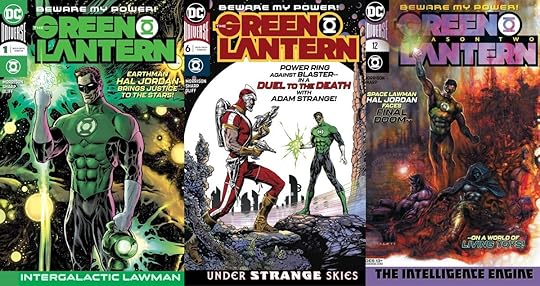 DC Comics
DC ComicsGrant Morrison is one of the greatest writers in modern comic book history, having written definitive runs for DC’s Superman, Batman, Justice League, and Wonder Woman. While we can’t say their Green Lantern run is a truly definitive run for the character, it definitely contained many interesting moments. In 2018, Morrison took on Green Lantern Hal Jordan, for a new ongoing series simply called The Green Lantern. The intricately detailed artwork for almost the entire run was provided by UK artist Liam Sharp, doing some career-best work.
Morrison, in their usual way, wanted to get weird with it. They focused more on Hal Jordan than the cast of thousands of the previous few years of GL mythos. In Morrison’s portrayal, Hal Jordan is an ordinary guy, just one whose mind expanded after years of experiencing cosmic incidents, death, and rebirth. Not everything lands in this run, as sometimes Morrison gets too esoteric for their own good for a Green Lantern title. But some of the ideas, and especially Sharp’s artwork, make this one to check out if you love Green Lantern.
Issues in Grant Morrison’s Green Lantern Run:The Green Lantern #1-18, Blackstars #1-3 (2018-2021)
9. Green Lantern War Journalby Phillip Kennedy Johnson and Montos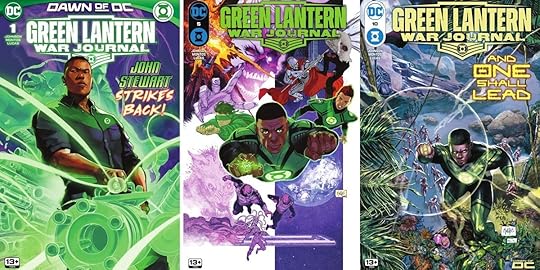 DC Comics
DC ComicsEven though he’s DC’s first African American superhero, there are too few instances where John Stewart headlined a solo Green Lantern title. The first time was the short-lived, yet weird and brilliant Green Lantern: Mosaic back in 1992. But in 2023, DC gave John another shot at a solo ongoing title, in the excellent Green Lantern: War Journal series. This book comes from the creative team of writer Phillip Kennedy Johnson, and artist Montos.
This series featured John Stewart attempting a quiet life on Earth, hoping to retire from the hero car. But soon, John is forced to wear the Power Ring once more when a deadly mystery emerges. This series reconciles the contradicting versions of the character. Was he the idealistic architect from the ‘70s, or the hard-nosed Marine from the 2000s era Justice League cartoons? Well, why not both? Sadly, this book is ending after just 12 issues this year. Yet the 11 issues we did get so far were pretty fantastic and worth your time.
Issues in Phillip Kennedy Johnson and Montos’ Green Lantern War Journal Run:Green Lantern War Journal #1-12 (2023-2024)
8. Green Lantern Corps (vol. 1)by Steve Englehart and Joe Staton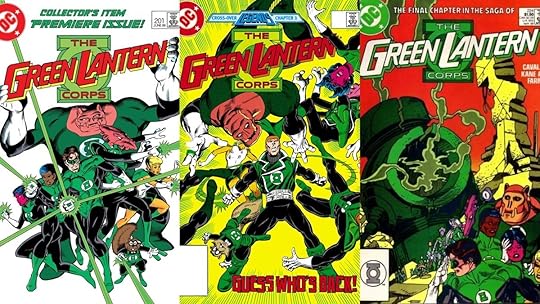 DC Comics
DC Comics In the early ‘80s, Green Lantern comics were stuck in a rut. Hal had left Green Arrow behind and became a solo act after a decade. Yet aside from the back-up Tales of the Green Lantern Corps from a young Alan Moore, nothing about Green Lantern as a comic was very exciting anymore. DC decided to retire Hal and replace him with John Stewart for an extended period, and later Guy Gardner. But even that didn’t increase sales significantly. So with the events of Crisis on Infinite Earths, DC decided to change things up big time. Green Lantern would become a superhero team book.
With issue #201, Green Lantern became Green Lantern Corps. On writing duties was Avengers and Batman veteran Steve Englehart, with stylized art by Joe Staton. After the events of Crisis, the Guardians departed this reality, leaving their Corps members to chart their own destinies, abolishing space sectors. A group of Lanterns led by Hal Jordan became a team, including John Stewart, his alien wife Katma Tui, Guy Garnder, the alien chipmunk GL named Ch’p, and a brand new Lantern named Kilowog, who would become a fan-favorite. This run proved the GLC as a team book could work, even if the series only lasted 24 issues. For some reason, this series isn’t collected today, an oversight DC should correct right away.
Issues in Steve Englehart and Joe Staton’s Green Lantern Corps Run:Green Lantern Corps vol. 1 #201-224 (1986-1988)
7. Far Sector by N.K. Jemisin and Jamal Campbell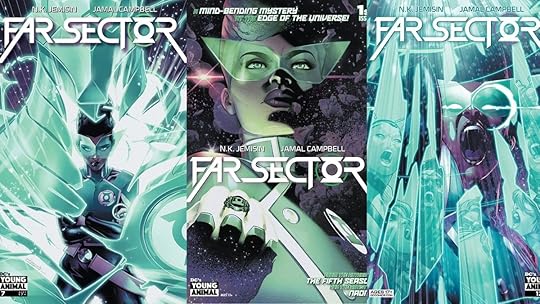 DC Comics
DC ComicsThis limited series was written by sci-fi author N.K. Jemisin, and illustrated by Jamal Campbell. It focused on an entirely brand new hero, the Green Lantern Sojourner “Jo” Mullein. And yes, she’s another Green Lantern from Earth (really, that’s like ten Earth Lanterns now. Enough DC!) A former military officer and ex-cop, Jo has been recruited by the Guardians of the Universe to keep the peace on a planet in the furthest known reaches of known space. She even uses a special Power Ring that slowly recharges on its own instead of needing to recharge with a battery.
The story of Far Sector starts as Jo Mullein becomes a cosmic detective, investigating the first murder victim in 500 years on a distant world. Unlike most G.L. stories, Far Sector actually remembers that the Green Lantern Corps aren’t really space soldiers, they’re actually space police. And in space and on Earth, policing, and what it means to those with no power, creates complications. This is a relatively recent series, released in 2020. But it’s a fantastic standalone story that deserves a lot more attention. Thankfully, Sojourner “Jo” Mullein has since been incorporated into the larger DC Universe.
Issues in N.K. Jemisin and Jamal Campbell’s Far Sector Run:Far Sector #1-12, 2020-2022
6. Green Lantern: Emerald Dawnby James Owsley, Keith Giffen, Gerard Jones, and M.D. Bright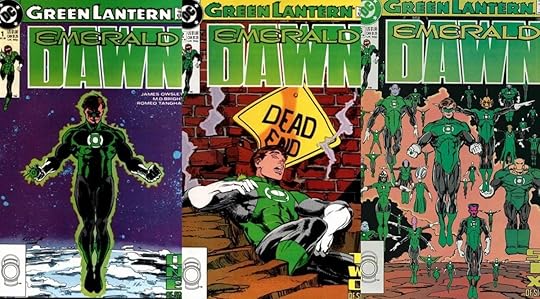 DC Comics
DC ComicsAfter the end of the Green Lantern Corps, there were only two Green Lanterns on Earth again—Hal Jordan and Guy Gardner. Guy was in the popular Justice League International series, but Hal Jordan, the OG, was without a home. So in 1989, DC decided to give Hal Jordan’s origin story a modern, post-Crisis update, with the limited series Green Lantern: Emerald Dawn. It was a testing ground to see if Hal was popular enough to headline an ongoing series again. The book, by writers James Owsley, Keith Giffen, and Gerard Jones, with art by M.D. Bright, was an instant hit, spawning an immediate sequel, and eventually a new ongoing series.
This six-issue mini-series added important new elements to Hal’s backstory, like the fact that he wasn’t all that perfect and upstanding before becoming a Lantern anymore, struggling with many personal issues before Abin Sur’s Power Ring chose him. These problems included prison time for a car accident that he caused while under the influence. Emerald Dawn also introduced the idea that future arch-villain Sinestro was Hal’s trainer as a GL, something that remains a facet of his story to this day. The art by the late M.D. Bright is the right mix of modern and classic, making this still a fun read today.
We should note that one of the three writers on Emerald Dawn, Gerard Jones, is a convicted criminal charged with fairly horrible crimes, which is likely why the series has remained out of print.
Issues in Keith Giffen, James Owsley, Gerard Jones, and M.D. Bright’s Green Lantern: Emerald Dawn Run:Green Lantern: Emerald Dawn #1-6 (1989-1990), Green Lantern: Emerald Dawn II (1991)
5. Green Lantern (vol. 2)by John Broome, Gardner Fox, and Gil Kane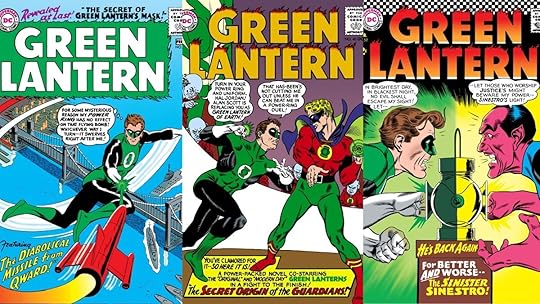 DC Comics
DC ComicsThe foundation for everything we know and love about the Green Lantern mythology is firmly rooted in the Silver Age stories of writers John Broome, Gardner Fox, and artist Gil Kane. Yes, a Golden Age Green Lantern existed before during WWII, Alan Scott. Yet it was these 1960s stories that defined who and what Green Lantern really is as a concept for the rest of time. In 1959’s anthology title Showcase #22, they took the name Green Lantern and built a whole new sci-fi mythology around it. With a new lead hero, Hal Jordan, rooted in the Atomic Age space race of the day, Green Lantern as a series was much better on the second try.
During this iconic Silver Age Green Lantern run, they not only introduced Hal Jordan. They also introduced the entire Green Lantern Corps, the Guardians of the Universe, Sinestro, and so many other concepts that remain to this day. Yes, the characterizations of the characters are often bland and one-note. There’s an undeniable goofiness to it all. That was just the era. Not to mention, Hal’s adventures and adversaries are way too Earth-bound during this time. But the imaginative storytelling and Gil Kane art will win you over. Even if it would take a later generation of writers to truly make Green Lantern great.
Issues in John Broome, Gardner Fox, and Gil Kane’s Green Lantern Run:Showcase #22-24, Green Lantern vol. 2 #1-60 (1959-1960)
4. Green Lantern Corpsby Peter J. Tomasi and Patrick Gleason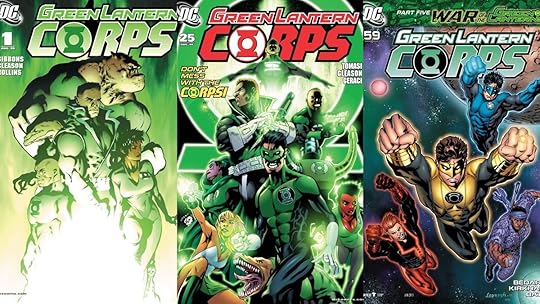 DC Comics
DC ComicsEveryone cites Geoff Johns’ epic run on Green Lantern as peak superhero storytelling. As well they should. But during the Johns era, the companion Green Lantern Corps ongoing series from writer Peter J. Tomasi and artist Patrick Gleason was often just as good—sometimes even better—than the flagship book. After the successful Green Lantern Corps: Recharge mini-series, DC took a chance on an ongoing GLC series again. This series almost totally takes place in space, with Honor Guard Lanterns John Stewart, Guy Gardner, Kyle Rayner, and others taking center stage.
In addition to the Earth Lanterns, exciting new characters like Sinestro’s replacement GL, Soranik Natu, were introduced in this series. When Green Lantern Corps was read simultaneously with Johns’ main Green Lantern title, it all felt like one epically large cosmic story when read together. Although Watchmen artist Dave Gibbons wrote the first couple of arcs, Peter J. Tomasi takes over for most of the rest of the run. Throughout all of this, you get the gorgeous artwork of Patrick Gleason. That alone makes this run an all-timer.
Issues in Peter J. Tomasi and Patrick Gleason’s Green Lantern Corps Run:Green Lantern Corps vol. 2 #1-47 (2006-2010),
3. Green Lantern/Green Arrowby Denny O’Neil and Neal Adams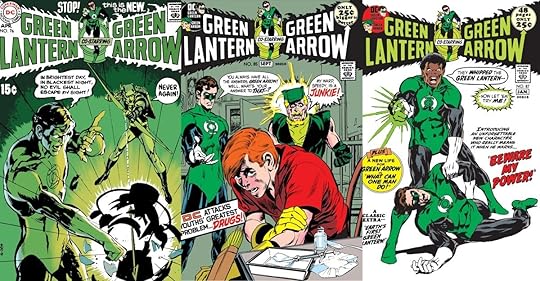 DC Comics
DC ComicsBy the end of the Silver Age, American comics were changing. More college kids than elementary school children were reading them. The stories themselves started to deal with more mature subjects and complex characterizations—especially at DC’s rival Marvel Comics. So in 1970, DC tasked young writer/artist duo Dennis O’Neil and Neil Adams, who also reinvented Batman, with reinventing Green Lantern as a socially relevant series. And they brought on Green Arrow as a co-lead, creating one of the comics’ best bromances. Green Lantern officially changed to Green Lantern/Green Arrow with issue #76.
During O’Neil and Adams’ “Hard Travellin’ Heroes” run, Hal Jordan represented conservative, establishment America. Oliver Queen’s Green Arrow was recreated as an almost hippy, hyper-leftist superhero. The two were oil and water, and they traveled America facing the issues of the day, like racism and drug abuse. Even Manson-like cults! Sometimes the writing was a bit preachy and on the nose, but the artwork and dynamic storytelling from O’Neil and Adams always sold it. This run saw the introduction of John Stewart, another reason it’s a milestone series. Hal and Ollie would remain partners for the entire ‘70s. Yet it was the O’Neil/Adams run that is the gold standard, even still.
Issues in Denny O’Neil and Neal Adams’ Green Lantern/Green Arrow Run:Green Lantern/Green Arrow #76-89 (1970-1972)
2. Green Lantern (Vol. 3) by Ron Marz and Daryl Banks, Paul Pelletier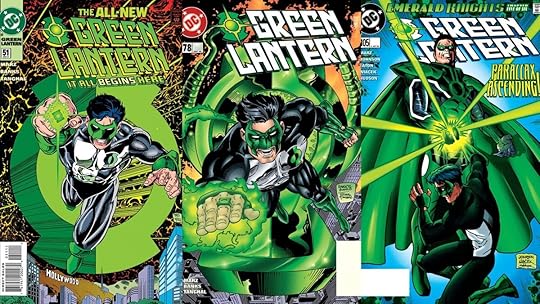 DC Comics
DC ComicsIn 1994, the comic book industry took a giant hit when the so-called comic book crash happened. Sales on once-popular franchises like Green Lantern, which a couple of years prior had three titles and a quarterly, were in freefall. So DC gambled. As a result of events during their Death and Return of Superman storyline, Hal Jordan lost his marbles, killed what remained of the GL Corps, and became the villain Parallax. All in the mere span of 3 issues. Only one power ring remained, and it went to a twenty-something slacker in a Nine Inch Nails t-shirt. And with that, Green Lantern was reborn.
In 1994’s Green Lantern #50, the last Guardian of the Universe gave out-of-work artist Kyle Rayner the last Power Ring, and he shaped himself into the universe’s last Green Lantern. A total 180 from Hal Jordan, Kyle was more like the readers—young, relatable, and more interested in art than airplanes. Ron Marz took on writing chores with Daryl Banks on pencils, and together they created a hero for the ‘90s that remains a fan favorite. Kyle had Spider-Man levels of average-guy superhero soap opera, all while trying to live up to a legendary legacy. Marz wrote the first issues, during much of which Green Lantern was once again a backbone of DC’s publishing line. Hal returned a decade later, but Kyle’s run as GL is undeniable.
Issues in Ron Marz’s Green Lantern Run:Green Lantern vol. 3 #48-125 (1994-2000)
1. Green Lantern (vol. 4, vol. 5)by Geoff Johns, Ivan Reis, Ethan Van Sciver, Doug Mahnke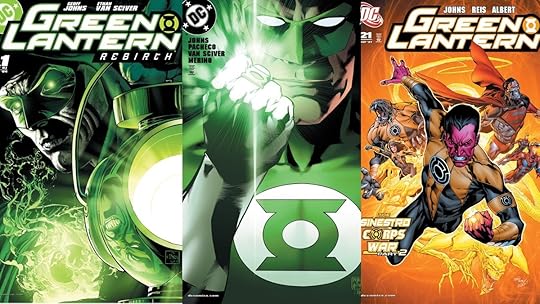 DC Comics
DC ComicsWhen it comes to Green Lantern comic book runs, few would argue that writer Geoff Johns‘ nearly ten-year run on the title is the GOAT. When Johns came on board for GL in 2004, the character was in a downturn. Kyle Rayner was still the main Lantern, but the series had lost steam after a decade. Especially without Rayner’s creator Ron Marz at the helm. Hal Jordan had gone from villain to dead to the ghostly hero the Spectre. The Corps was disbanded. It was a bit of a broken franchise. Writer Geoff Johns fixed all that almost overnight, starting with the blockbuster mini-series Green Lantern: Rebirth.
In Green Lantern: Rebirth, Johns and artist Ethan Van Sciver re-energized the series by bringing Hal Jordan back from the dead, as well as his main rival Sinestro. They also created a plausible explanation for Hal’s turn to the dark side a decade earlier, creating the fear entity Parallax, which we learned possessed Hal. During the Johns run, alongside artists like Ivan Reis and Doug Mahnke, they expanded the Green Lantern mythology like no ever had before. Together, they created some of the best ongoing superhero yarn-spinning of the last few decades.
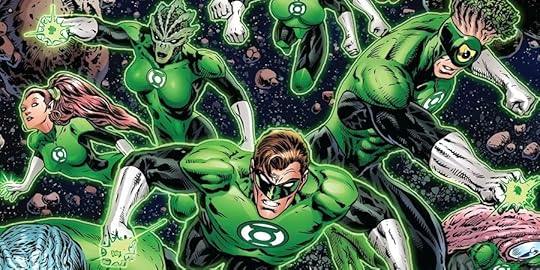 DC Comics
DC ComicsDuring his tenure, Johns created the Sinestro Corps, introduced the concepts of the Emotional Spectrum, the other colored Lantern Corps, like the rage-fueled Red Lanterns, the Third Army, and maybe the peak of the franchise, Blackest Night. This mini-series introduced the zombie-like Black Lantern Corps, made up of the animated corpses of dead DC characters. Geoff Johns’ run on Green Lantern was so epic, that no writer since has ever been able to top it. For a brief time, Geoff Johns turned Green Lantern into DC’s second-biggest franchise after Batman. And it will be a long time before its light goes out in the hearts of fandom.
Issues in Geoff Johns’ Green Lantern Run:Green Lantern: Rebirth #1–6 (2004–2005), Green Lantern vol. 4 #1–67 (2005–2011) Green Lantern vol. 5 #0–20 (2011–2013) Blackest Night #0-9 (2009-2010)
The post The 10 Greatest Green Lantern Comic Book Runs, Ranked appeared first on Nerdist.
HALO Series Is Canceled at Paramount+
Alas, although it’s been a heyday for gaming series adaptations, with shows like Fallout and The Last of Us making a huge impression on audiences, one gaming adaptation won’t be moving forward. Paramount+’s Halo series has been canceled after two seasons.
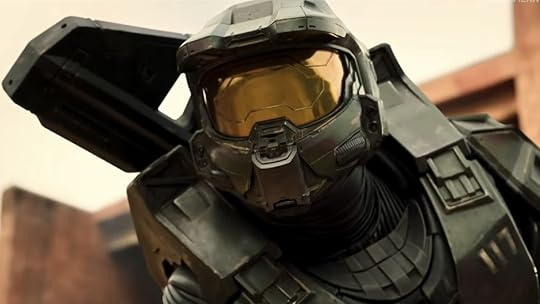 Paramount+
Paramount+Paramount+ shared of Halo‘s cancellation: “We are extremely proud of this ambitious series and would like to thank our partners at Xbox, 343 Industries and Amblin Television, along with showrunner and executive producer David Wiener, his fellow executive producers, the entire cast led by Pablo Schreiber as Master Chief and the amazing crew for all their outstanding work… We wish everyone the best going forward.”
The path to the now-canceled Halo adaptation series was not an easy one. The show went through many iterations and changes in direction before finally premiering on Paramount+ in 2021. Ultimately, the reception of the show was not very positive. According to The Hollywood Reporter, the show’s producers will attempt to pursue a third season of Halo on a different platform. We wish fans of the Halo series luck in un-canceling it and finding it a new home!
The post HALO Series Is Canceled at Paramount+ appeared first on Nerdist.
Netflix Won’t Bundle with Other Streamers Since ‘It Is Already a Go-To Destination’
We all have to know our worth. And Netflix certainly knows theirs. They’re not closed to joining certain kind of bundles, but they won’t be entering into a streaming bundle with fellow streamers Disney+ or Max. And that’s because Netflix simply doesn’t need to join a group of its peers. According to the platform, Netflix won’t be bundling with other streamers because “Netflix already operates as a go-to destination for entertainment.” Alright Netflix, tell us how you really feel!
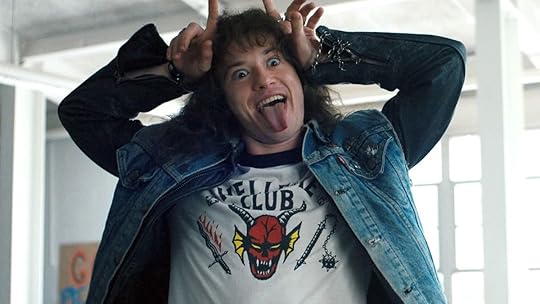 Netflix
NetflixRecently, we’ve seen streaming bundles become more mainstream. On the one hand, we saw a Disney+, Hulu, and Max streaming bundle come into being. And on the other, we saw Peacock, Netflix, Apple TV+ join forces to create a streaming bundle of their own. But don’t expect Netflix to appear in any of these.
Netflix shares in a letter to shareholders that it will join a bundle with device and operator partners, which “mak[e] it simple for people to discover, sign-up, use and pay for Netflix.” And “In turn, our device and operator partners benefit through increased device sales from consumers seeking devices integrated with Netflix and greater customer acquisition and higher retention as well as the opportunity to upsell higher value data or content packages.” However, Netflix will not soon enter into a streaming bundle agreement with its peers.
 Netflix
NetflixThe streamer shares, “We haven’t bundled Netflix solely with other streamers like Disney+ or Max because Netflix already operates as a go-to destination for entertainment thanks to the breadth and variety of our slate and superior product experience. This has driven industry-leading penetration, engagement and retention for us, which limits the benefit to Netflix of bundling directly with other streamers.”
Shots fired! Apparently, Netflix specifically called out the Disney+, Hulu, and Max bundle in its statement. It’s definitely a bold statement to make. We’ll see if Netflix maintains this position as the streaming industry continues to oscillate.
The post Netflix Won’t Bundle with Other Streamers Since ‘It Is Already a Go-To Destination’ appeared first on Nerdist.
Best Deadpool Comic Book Runs, Ranked
The world was in a much different place when Wade Wilson, aka Deadpool, made his comic book debut in The New Mutants in 1990. The first of two Bushes was President, Nirvana had yet to release Nevermind, and the only superheroes who had movies were Superman and Batman. It took many years and a whole lot of writers and artists, but eventually, Deadpool rose the ranks to become a genuine superstar in the vast canon that is the Marvel Universe.
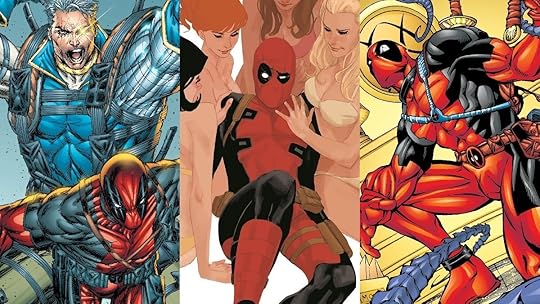 Marvel Comics
Marvel ComicsToday, you can’t walk around the mall (if there’s still one open near you) and not see Deadpool somewhere. The Merc with the Mouth is a serious pop culture icon, his red and black mask plastered onto t-shirts, hoodies, Funko figures, and so much more. With not one, not two, but three theatrical movies under his belt, one could argue Deadpool is as big as Mickey Mouse.
In the world of comic books, dozens of brilliant comics writers have shaped Deadpool into the wisecracking, chimichanga-munching anti-hero we know him to be. While Ryan Reynolds tears up the screen yet again as Deadpool in the new Deadpool & Wolverine, it’s high time to look back at some of the all-time greatest Deadpool comic runs. Whether you’re a completionist looking to curate the perfect library or a newbie still dipping a toe into comics, or someone in between, this list is for you if you need a little Deadpool in your life. (Don’t we all?)
9. Deadpool by Mark Waid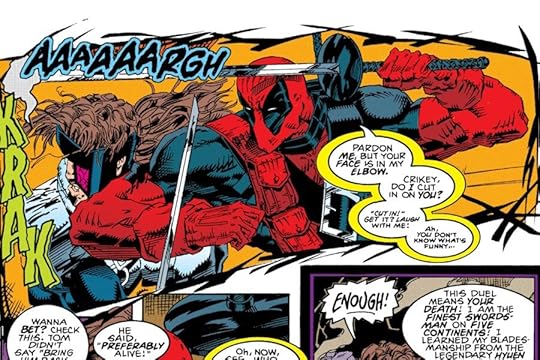 Marvel Comics
Marvel ComicsDeadpool’s metamorphosis into the wisecracking, fourth wall-breaking mercenary we know him now was a slower evolution than you might think. Revisit his debut in The New Mutants and early X-Force appearances and you’ll find a different Wade Wilson than you know today. This isn’t to say Deadpool wasn’t a blabbermouth back then, but his personality hardly stood out from the other hard-edged mutants he was pitted against. After the mild success of his first solo mini, Deadpool: The Circle Chase by Fabian Nicieza and Joe Madureira, there came a second miniseries that has flown under the radar since its 1994 publication, simply titled Deadpool by writer Mark Waid (with art by Ian Churchill, Jason Temujin Minor, and Bud LaRosa).
While it lasts just four issues, Waid – who was in the midst of a hot streak at the time, with titles like The Flash and later Kingdom Come at DC – strikes a fine balance between dark, edgy machismo with Deadpool’s developing humor. The story isn’t much to write home about; Deadpool’s favorite bar gets wrecked, and so the Merc teams with mutants like Siryn and Banshee for payback all while his healing factor malfunctions. But the visual art is peak ’90s maximalism, combined with a dash of Waid’s belief that Deadpool will get what’s coming to him – or so Waid thought. In a 1997 interview with Wizard, Waid later expressed regret writing the series, saying: “Someone who hasn’t paid for their crimes presents a problem for me.”
8. Hawkeye vs. Deadpool by Gerry Duggan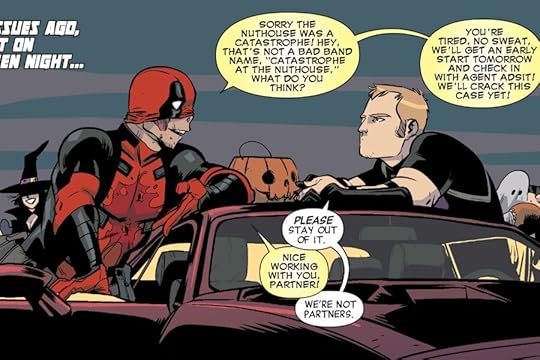 Marvel Comics
Marvel ComicsYou’ll pardon the awkward numbering of the five-issue miniseries Hawkeye vs. Deadpool, which begins with issue #0 and ends with issue #4. But this delightful action-comedy romp splatters the walls with hilarious bits that really put the “comic” in comic books. Beginning on Halloween night, Deadpool runs into Hawkeye, with the two quickly teaming up to investigate a murder mystery involving a dead body and a strange USB drive. (It makes a curious case of the word “vs.” in the title, to be frank.)
Continuity-wise, the miniseries intersects with Gerry Duggan and Brian Posehn’s monthly Deadpool (including a gut-busting cameo from the ghost of Ben Franklin, originating from the first story arc). It also in a lot of ways acts as a spiritual continuation of Matt Fraction’s acclaimed Hawkeye. But Hawkeye vs. Deadpool is so fast-paced and such a fun read that you don’t need to read anything else even if you’re a dedicated completionist. If you need to kill a single afternoon and want to split your sides, Hawkeye vs. Deadpool is a real bullseye.
7. Black Panther vs. Deadpool by Daniel Kibbelsmith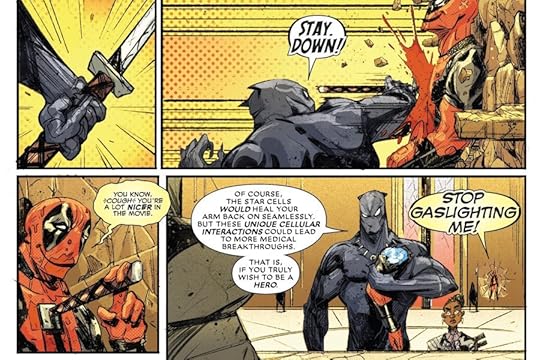 Marvel Comics
Marvel ComicsWhen Marvel’s Black Panther grossed billions at the box office in 2018, everything about him exuded untouchable royalty. But only a transgressive, innocently offensive character like Deadpool could dare scratch the king of Wakanda. From writer Daniel Kibbelsmith, the five-issue crossover miniseries Black Panther vs. Deadpool wholly banks on the oddball novelty of its marquee characters duking it out.
After Deadpool’s efforts to save Brooklyn from a Z-list villain results in collateral damage, Deadpool embarks on an urgent mission to Wakanda to retrieve precious Vibranium in order to save a life. While Deadpool politely asks T’Challa at first, the noble Black Panther rebuffs him, leading the two to put claws to katanas. With former Late Show with Stephen Colbert writer Kibbelsmith at the helm, Black Panther vs. Deadpool is a propulsive read. It’s a breezy collision of action and comedy in a showdown no Marvel fan knew they wanted until now. The visual art matches the manic energy of the miniseries, with both Deadpool and Black Panther looking especially feral in jagged and slanted lines.
6. Deadpool by Joe Kelly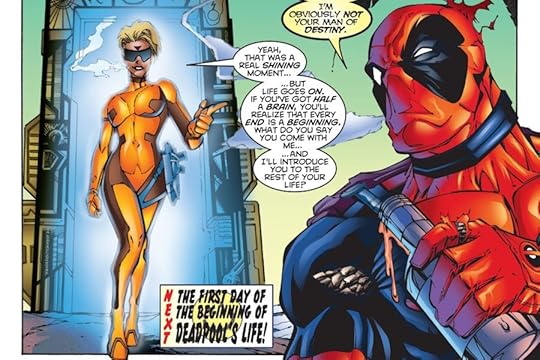 Marvel Comics
Marvel ComicsIf you want the origins of Deadpool, the character, read The New Mutants. If you want the origins of Deadpool, the satirical and determined jester in red spandex who takes on life one katana swing at a time, read Deadpool by Joe Kelly.
After establishing himself at Marvel on works like Fantastic Four 2099, Joe Kelly embarked on his first monthly assignment: a new Deadpool series in 1997. This very lengthy run gave us most of the hallmarks fans associate Deadpool with today: the breaking of the fourth wall, the abundant pop culture references, even Deadpool’s annoyance factor that gives everyone else in the Marvel Universe a headache. (Wanna see Deadpool reference Street Fighter and uppercut Kitty Pryde while screaming “Shoryuken”? That’s issue #27.)
But past all the juvenile humor is the pathos of a lonely soul who bounces around like an unwanted pinball. Rob Liefeld and Fabian Nicieza shaped Deadpool out of clay, but it was Joe Kelly who gave him a lasting presence. After Kelly’s run on the ’97 Deadpool ended with issue #33, with the series taken over by Christopher Priest (whose run is less acclaimed but no less interesting) and then a series of other freelance scribes before Gail Simone took the series home to – and Deadpool would giggle at this – issue #69.
Issues in Joe Kelly’s run: Deadpool #-1 (flashback one-shot published after issue #6), Deadpool #0, Deadpool #1-33, Annual Deadpool & Daredevil ’97, Annual Deadpool & Death ’98
5. Uncanny X-Force by Rick Remender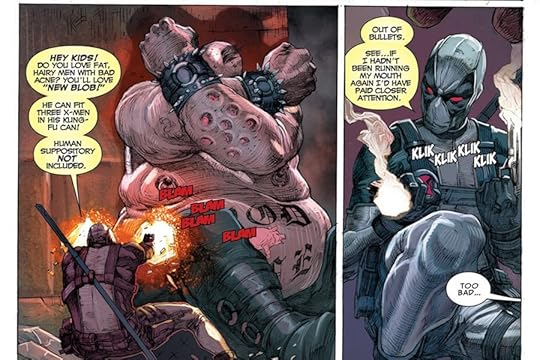 Marvel Comics
Marvel ComicsDeadpool has never been much of a team player. But that all changed in Rick Remender’s Uncanny X-Force, a continuation of the 2008 X-Force by Craig Kyle and Christopher Yost. Remender’s story picks up after Cyclops shuts down X-Force, with Wolverine covertly keeping operations running as X-Force leader. This new iteration of X-Force consists of Psylocke, Fantomex, Archangel, and Deadpool, who all adopt an incredibly sick black and white uniform color scheme. (Honestly, more superhero teams should adopt unified colors like pro sports.)
Deadpool maintains his rep as a jokester, but Uncanny X-Force turns down the volume on his obnoxiousness to suit the series’ overall serious tone. This doesn’t mean Deadpool takes it easy on Apocalypse, mind you. But Uncanny X-Force isn’t Deadpool’s show to steal, as the Merc lets his pal Wolverine and the more enigmatic Fantomex take up more attention as the series’ main protagonists. Between its gorgeous art and strong character-oriented writing, Uncanny X-Force is not just a great Deadpool title but a great X-Men-adjacent title overall.
4. Deadpool: Bad Blood by Rob Liefeld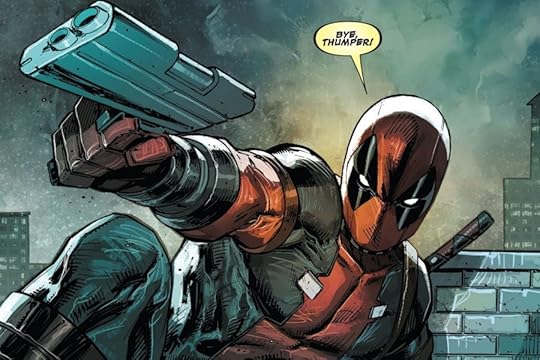 Marvel Comics
Marvel ComicsSay what you want about Rob Liefeld. When you read a Deadpool comic written by Liefeld, it’s like watching a Terminator flick directed by James Cameron: Nothing beats a proven creator working on their most famous creation.
In 2017, the popular if also divisive comics legend got the greenlight for Deadpool: Bad Blood, an entire Deadpool graphic novel. (Along for the ride are writers Chris Sims, Chad Bowers, and artists Romulo Fajaroo Jr. and Joe Sabino.) The contained series introduces a new nemesis for Deadpool, a thick brawler named Thumper whose past connections to Wade Wilson run deeper than most others in the Marvel Universe. Conceptually a celebration of Deadpool’s early history as seen through Liefeld – including a “reunion” of the original X-Force, albeit in flashback – Deadpool: Bad Blood has all the hallmarks of ’90s era Deadpool with modern touches. The awkward bodily anatomies and aggro aesthetic ain’t a bug baby. They’re all features.
3. Spider-Man/Deadpool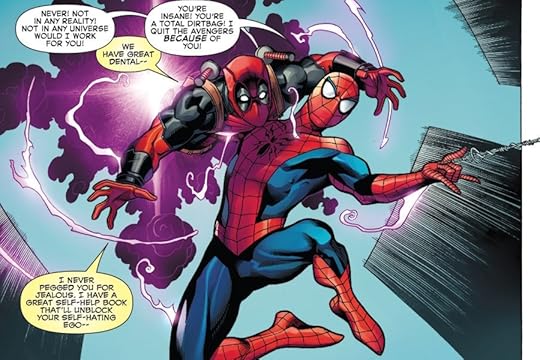 Marvel Comics
Marvel Comics2016 was a great year for Spider-Man and Deadpool. That year, Ryan Reynolds starred in the box office smash Deadpool, an R-rated party at the theater that fans waited for literal years to happen. Shortly after that, Tom Holland swung into his Marvel Cinematic Universe debut as Spider-Man in Captain America: Civil War. So it was excellent timing when Marvel published that same year Spider-Man/Deadpool #1, the first of an epic 50-issue series in which the friendly neighborhood wall-crawler puts up with the decidedly unfriendly assassin.
But while Spider-Man/Deadpool could have rested on its laurels with its A-list characters, the series’ revolving door of top tier writers were not content with mediocrity. Starting with veteran Deadpool writer Joe Kelly, Spider-Man/Deadpool relishes in the unabashed fun of a mismatched pair like Spidey and DP before further exploring what these characters mean to each other. For Spider-Man, he learns to see the person behind the violence and the humor; for Deadpool, he aspires to hold himself to a higher standard of costumed crime fighter. (Also: The series coincides with Peter Parker’s role of CEO of Parker Industries, so Deadpool’s interference of Spidey’s daily routine often gets extra funny.)
Whether it’s roasting Batman v Superman: Dawn of Justice (issue #6), running into Penn & Teller (issue #11), or speculating their elderly future in the multi-part arc “Oldies,” Spider-Man/Deadpool makes the absolute most of their unstoppable leads. In addition to Kelly, the series also sees writers like Scott Aukerman, Gerry Duggan, Paul Scheer, and Robbie Thompson take a swing at writing the delirious duo.
2. Cable & Deadpool by Fabian Nicieza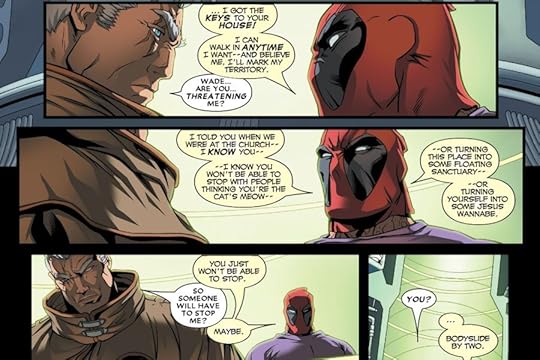 Marvel Comics
Marvel ComicsSometimes, sequels really are better than the originals. After both Deadpool and Cable’s solo titles were canceled, these two gun-toting mutants joined forces to star in Cable & Deadpool, easily one of the best mainstream superhero comics of the 2000s. Written by Fabian Nicieza (with artist Reilly Brown scripting the final two issues), Cable & Deadpool is quintessential 2000s superhero bombast with the distinct vibe of a classic buddy action movie.
The story starts with Cable determined to use his powers to change the world for the better only to wind up before Deadpool, who is hired by a cult to steal a virus that will uniformly turn everyone’s skin color on Earth blue. Eventually, Cable and Deadpool obtain the power of teleportation, with the utterly ingenious caveat being that whenever it’s used, they both teleport. From there, Cable and Deadpool become an unlikely but dynamic pair – plus a later addition in Bob, Agent of Hydra – who come face to face with everyone in the Marvel Universe, from the Fantastic Four to the Avengers to the then-married power couple of Black Panther and Storm.
Cable & Deadpool sports an array of different artists, all of whom bring to the table their own individual styles. That said, there is a pretty criminal overuse in digital airbrushing, as well as an overall aesthetic you could describe as “American manga” (a strange phenomenon unique to the mid-aughts, when anime was still in the midst of discovery by the American mainstream). But no matter how it looks, Cable & Deadpool is a delight from page to page, and proof that the end of one thing is always the start of something new.
1. Deadpool by Gerry Duggan and Brian Posehn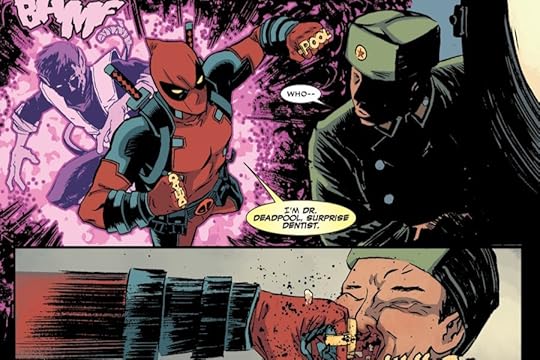 Marvel Comics
Marvel ComicsAs the dust settled on Avengers vs. X-Men, Marvel kicked off a new publishing initiative dubbed Marvel NOW. Among its biggest titles was a brand new monthly Deadpool series, co-written by veteran scribe Gerry Duggan and comedian Brian Posehn.
Once again bearing the simple title of Deadpool, the series restored a lot of lost glory for the Merc with the Mouth, following Deadpool figuring his place in the wider Marvel Universe and enduring shocking revelations along the way. Minor spoilers, but at one point Deadpool meets his biological daughter, an adorable li’l mutant named Ellie Camacho.
The starting arc of Duggan/Posehn’s Deadpool is a doozy, in which an amateur sorcerer brings back the souls of dead U.S. presidents in hopes of – ahem, making America great again. (This came out in 2013, by the way.) While that first arc is divisive, the rest of the series is peak Deadpool, a masterful balance of DP’s antics and outrageous challenges with profound emotional angst. Across 45 issues, Duggan and Posehn’s Deadpool is the platonic ideal for anyone looking for a good time that goes for a long time.
The post Best Deadpool Comic Book Runs, Ranked appeared first on Nerdist.
THE BOYS’ Susan Heyward on Sage’s Machiavellian Mindset, Ulterior Motives, and Her Season 5 Hopes
Who would have ever thought that there’s a supe more dangerous than Homelander? That’s exactly what we got in The Boys season four, thanks to the arrival of Sister Sage. (Let’s just drop the “Sister” and call her Sage, okay?) The smartest person in the universe turned America’s government system and ongoing supe war into her own personal game of chess, using everyone around her as pawns to craft pure chaos.
Thanks to her sheer genius and others’ lack of emotional intelligence and self-control, supes are running the US and Homelander is their leader. Sage doesn’t care about societal conventions nor does she have powers that can protect her if she falters. Therefore, every move she makes is intentional, calculating, and downright diabolical. We caught up with The Boys actress Susan Heyward to talk about Sage’s psyche, fandom love, and the catharsis and life lessons from playing a radical character.
 Jasper Savage/Prime Video
Jasper Savage/Prime VideoNerdist: What was your favorite Sage moment in this season and why?
Susan Heyward: Oh, gosh, there’s so many! I have to say I loved Sage’s setup for Firecracker because I think it speaks to her nature. She met Firecracker and immediately got the “old boy racist” vibes from her. And Sage tucked that information away and waited for a moment when she knew that she could create a situation where Firecracker would go the direction that Sage wanted her to for her own benefit. The way Sage kind of stepped back and was like, ”I’m going to let you be who you are” and let her get her ass beat by somebody who has the power to do it… that was delicious to me.
It was fantastic. I’m glad you brought up a big part of Sage’s personality which is withholding information and using people’s worst natures against them. We get a chance to see her surface level motivations for wanting to work with Homelander. She doesn’t really think humanity is worth saving, which I do get. Do you think Sage has other ulterior motives against Homelander or is she just a Machiavellian agent of chaos who only wants to see the world burn?
Heyward: It is hard to choose, honestly, because I think she is processing so much information and so many possibilities all the time. I have to say it’s a little bit of both. I think she’s a survivor. The world has not necessarily been a kind place to her. So she’s always thinking about her own survival. Always thinking about how she can do what’s best for her. And I think she needs something to make her excited, something to give her a reason to live. She has the opportunity to create chaos and a universe that was unlikely. I think it gives her a thrill to help her feel alive.
It’s so interesting she’s doing all of this and purposely staying behind the scenes. To me, that makes her more threatening than anyone else on the show. Sage isn’t concerned with being loved nor adored by anyone and she’s certainly no one’s savior. As a Black woman, did you find any catharsis in being able to portray a woman who’s really unrestrained and rather radical?
Heyward: Absolutely. I feel like there’s so much pressure in our culture as a woman, especially as a Black woman, to be liked, to be nice, to see how we can be of use and of service to everyone we meet. And I found it really liberating to play a character whose concerns were living life on her own terms… I liked seeing that play out with her. It is liberating and I feel like we are seeing [something similar] play out with women in real life. Women are not so concerned with being liked and they aren’t making that the focus of their forward phase.
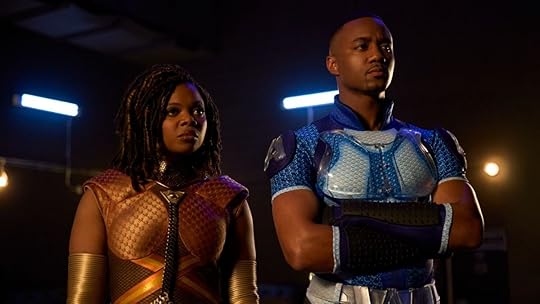 Jasper Savage/Prime Video
Jasper Savage/Prime VideoI absolutely love it! So, the season four finale sets Sage up to continue to play a big role in season five as Homelander’s advisor. What are some of your hopes and dreams for Sage’s storyline as we move forward?
Heyward: Oh, there’s so many things I’m pitching ideas for! I would say world domination is clearly one. [laughs] I’m also interested in seeing some of her personal life. We’ve got glimpses of her relationship with A-Train before they ended up on the Seven together. I’m interested in that. I’m also interested in getting more about her family, whom we don’t see her ever talk to. I think one of the biggest lessons Sage has taught me is how important it is to stay connected to your community. We find her in an isolated moment surrounded by her books, but not people… that’s affecting who she is… So I’d love to see her either finding community or dealing with the community that she’s lost in season five.
There’s definitely a possibility for that. A-Train was definitely disconnected from his community and his Blackness in many ways, and he’s found his way back. There’s hope for Sage to do that… somewhere in the mix of her world domination!
Heyward: We could totally get those two working together.
I’d like to see that. When it comes to Sage’s persona, I assume a lot of it came from what was written on page. But what other sources and characters did you draw from to build her characterization?
Heyward: That’s such a good question. I tried to watch a lot of chess matches because there’s this idea, I think especially in the media, that if you’re smart, you wear glasses and you don’t have a lot of confidence. That’s a media shorthand for what it means to be smart. And I wanted to watch people who were in the act of thinking, strategizing, and holding different possibilities in their mind. And there was such focus on the task at hand rather than the outside appearance or presenting or showing how much they’re working.
I found a lot of power in stillness, which is not me. I’m a naturally gregarious person. I thought it really fun to bring that stillness to Sage, especially in a world where everyone is almost cartoonish… I wanted to bring a certain mystery and stillness to her. And in talks with [showrunner] Eric Kripke, he said he saw Sage as a sphinxlike character. So I wanted to bring that sense of reserve to her.
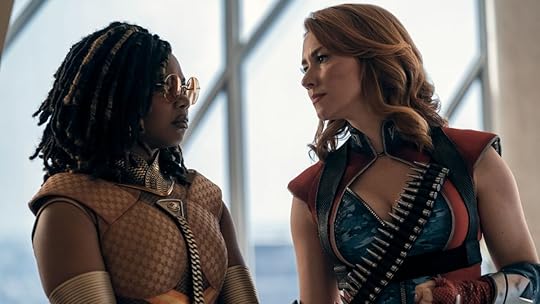 Jasper Savage/Prime Video
Jasper Savage/Prime VideoThat is a cool way to build a character. I enjoyed her juxtaposition to everyone else because, like you said, they can be so bombastic. Sage feels incredibly grounded, even down to her superpower of beyond genius intelligence. That seems like it could be tangible, minus the lobotomizing part.
Heyward: [laughs] Yes. And I feel like not giving her those types of physical powers away affects her. She cannot take as many risks. So there’s this line that she’s always dancing, certainly with Homelander, Firecracker, and with anyone who has these huge physical powers. If she moves too fast in the wrong way, those laser eyes are going to catch her. So there’s a juxtaposition of her intelligence strength with her physical vulnerability that made for nice tension.
It certainly puts her in a precarious place but she’s making it work! Now that the season is over and you’ve seen the fandom love for Sage, what does it feel like to be a part of something so bonkers yet beloved? And how has portraying Sage changed you as a person?
Heyward: I’m deeply grateful and excited. I was a fan of the show from season one, and I personally was hoping for someone like Sage. So to be in a position to actually be that person and have the creative input, I feel very, very grateful and excited for what’s to come. It’s surreal, I have to say. There’s a bit of distance between who I am and the character.
So I feel like I’m on the sidelines watching the audience have this relationship with Sage that has only a little bit to do with me… I love seeing Black women see themselves. I think I saw one post on Instagram that was like, apparently people say Sage is my doppelganger. And then she put a picture of herself next to some stills of Sage and I was like, “Oh my gosh, she does look like me!” Long lost cousin, where you at?! What’s up?! [everyone laughs]
Sage has helped me deal with my own need to be liked and confront my own habits of maybe people-pleasing or leaning into cuteness or niceness in order to survive this crazy world and get what I need. I’m letting my voice drop a little lower and have some bass when normally I would use a higher pitch. There are all of these unconscious ways that we make ourselves smaller or we make ourselves palatable for people. I’ve become far more aware of the ways I used to lean into that and I get to choose to do something else. And that’s thanks to Sage.
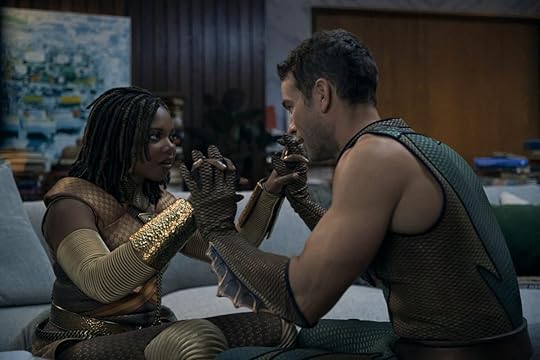 Jasper Savage/Prime Video
Jasper Savage/Prime VideoI feel you on that, deeply. Sage’s unapologetic boldness is inspiring. I know you say you are mostly not like Sage, so which The Boys character are you like?
Heyward: I think I’m most like Hughie.
Really?! That’s interesting.
Heyward: Yeah, there’s something so beautiful about Hughie’s appeal to humanity. He does not want to become a monster in order to fight the monsters. He looks up to Butcher and also has this deep hope that Butcher doesn’t become one of the monsters. He’s fighting them and always appealing to mercy or inclusion or grace for people. Hughie is also struggling with the monster in himself, the ways he has internalized sexism, the way he deals with Starlight, the way he wants to be a good guy, but he’s always confronting the ways in which he’s not that great. I feel like that’s what it is to be human, to try to hold onto your humanity, but also be really interested in the ways you’re falling short of who you want to be. And always keep trying to be better.
I love that about him. And I also love that Sage got to be a full force villain, too. It feels like a win for us, you know?
Heyward: Yes! Thank you so much for your questions, for being excited, and for watching. It’s truly the reason I do what I do, I want to create feelings like that.
.youtube-embed{padding-bottom:56.25%!important;position:relative;overflow:hidden}.youtube-embed a,.youtube-embed iframe{display:block;width:100%;height:100%;position:absolute}.youtube-embed iframe{border:0}.youtube-embed img.youtube-cover{-o-object-fit:cover;object-fit:cover;height:100%;width:100%;cursor:pointer}.youtube-embed img.play-button{width:66px;position:absolute;left:46%;top:0;bottom:0;margin:auto;cursor:pointer}@media only screen and (max-width:499px){.youtube-embed img.play-button{left:45%;width:60px}}@media only screen and (max-width:425px){.youtube-embed img.play-button{left:44%;width:60px}}@media only screen and (max-width:375px){.youtube-embed img.play-button{left:43%;width:56px}}@media only screen and (max-width:345px){.youtube-embed img.play-button{left:42%;width:50px}}.youtube-embed .progressive-img{-webkit-filter:blur(10px);filter:blur(10px)}.youtube-embed .progressive-img.loaded{-webkit-filter:none;filter:none;-webkit-transition:-webkit-filter 1s ease-out;transition:-webkit-filter 1s ease-out;-o-transition:filter 1s ease-out;-moz-transition:filter 1s ease-out;transition:filter 1s ease-out;transition:filter 1s ease-out,-webkit-filter 1s ease-out}.youtube-embed .kskdDiv{display:none!important}The post THE BOYS’ Susan Heyward on Sage’s Machiavellian Mindset, Ulterior Motives, and Her Season 5 Hopes appeared first on Nerdist.
THE ACOLYTE’s Senator Rayencourt Could Have Saved the Jedi From Themselves
The Acolyte takes place during the High Republic Era, the “golden age of the Jedi Order.” Star Wars fans know that time period is followed by total darkness. A century later, the Sith will emerge from the shadows, slaughter their ancient enemy, and rule the galaxy far, far away. Jedi hubris during the Clone Wars will help make their downfall possible. But now, we’ve seen firsthand how the Order could have avoided their own destruction long before Sheev Palpatine even become a Sith apprentice. The Acolyte‘s Senator Rayencourt saw something the Jedi couldn’t: their own flaws. And if they had accepted the kind of oversight we know the Order so desperately needed, its golden era might have never ended.
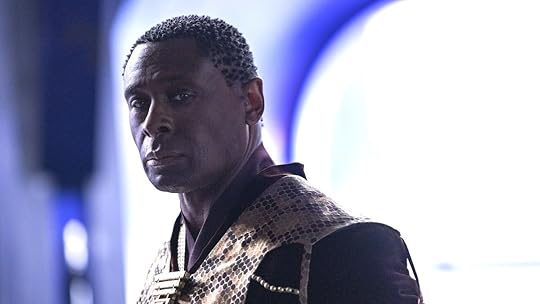 Lucasfilm
LucasfilmMaster Vernestra spent season one of The Acolyte trying to hide a terrible truth from the Galactic Senate. She did not want any outsiders—even the elected officials whom the Jedi were supposed to answer to—to learn about the murder of their own kind by an unauthorized Force user trained by a former Jedi Padawan. Vernesra and her colleagues didn’t even tell their own High Council what was happening, because the Jedi governing body made up of the wisest, most experiences Masters reported directly to the Senate.
Before Vernestra went to Brendok and learned the truth about what happened there, she spoke with the Order’s biggest critic, Senator Rayencourt. His name came up during the season because he was hoping the Galactic Senate would order an independent, external investigation into the Jedi. In his confrontational meeting with Vernestra he laid out his honest, unvarnished reason for questioning the Jedi.
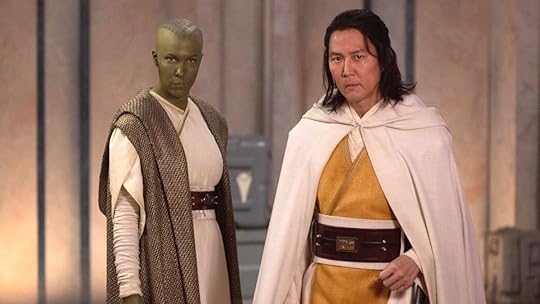 Lucasfilm
Lucasfilm“I think the Jedi are a massive system of unchecked power, posing as a religion, a delusional cult that claims to control the uncontrollable,” he said. When Vernestra responded (without challenging anything else he said) she told him the Jedi don’t control the Force. That wasn’t what he meant. “Not the Force. Your emotions,” he said. “You project an image of goodness and restraint, but it’s only a matter of time before one of you you snaps. And when, not ‘if’ that happens, who will be strong enough to stop him?”
The specter of Anakin Skywalker hung over the entire scene. Everything Rayencourt said will happen. Anakin will be unable to control the very emotions the Jedi failed to teach him to command. His lack of restraint over fear, pain, and sadness, will overcome his goodness and he will snap. No one will be able to stop him when he does. Many will die. The Jedi will fall. Darkness will consume the entire galaxy.
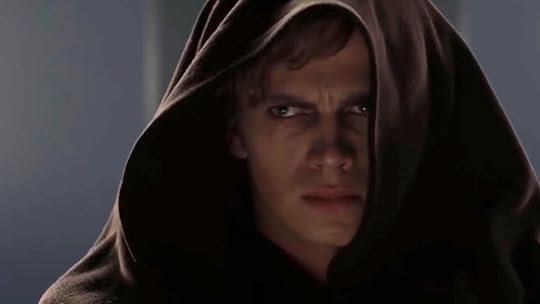 Lucasfilm
LucasfilmRayencourt could see that tragic fate coming even if the rest of the Senate could not. “The majority of my colleagues cannot imagine a galaxy without the Jedi, and I can understand why,” he said. “When you’re looking up to heroes you don’t have to face what’s right in front of you.” He’s right, and not just about the people who put their faith in the Jedi. It will be true of the Jedi themselves.
They will be so sure of their position, held for millennia, they will not see what’s right in front of them. Rather then serve as guardians of peace and justice for all, they will foolishly serve as generals in a war secretly led by a Sith Lord. Their unquestioned belief in their own abilities, in their own goodness, and in their own heroism will lead to their own fall. They will put themselves on a pedestal and never question why they’re up there. From their perch, lies will sound good. Wars will be justified. And a Sith will operate in the shadow they create.
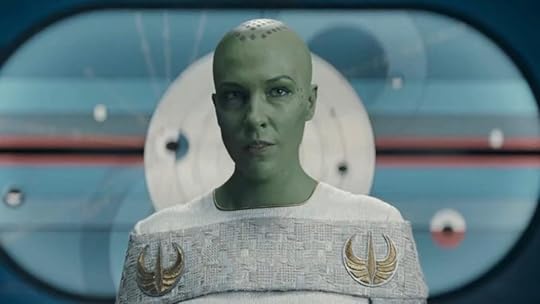 Lucasfilm
LucasfilmIt didn’t have to be that way and it shouldn’t have been. Rayencourt’s review could have brought to light the obvious issues with the Jedi Order, both the danger of its beliefs and its position in the galaxy. Unchecked power, even for those with “noble intentions,” will ultimately lead you astray. Especially when it requires you to deny the very thing that connects you to others: your emotions. Putting yourself above anyone will blind you to your own flaws. The longer those flaws go untreated the larger they grow and the more vulnerable you become.
The Jedi ruled for thousands of years, unaware their own shortcomings were getting larger with every generation. Eventually they stretched themselves so thin the Sith saw a chance to capitalize. And they were able to do so manipulating the very Senate the Jedi had kept in the dark.
Master Vernestra told terrible lies unbecoming a Jedi for what she thinks is a greater cause. She believes the Jedi, and only the Jedi, know what is best for themselves, and by extension the whole galaxy. Because Vernestra believed that she wanted to protect herself and her Order from the prying eyes of outsiders. If only she’d been willing to hear some hard truths she might have done just that.
Mikey Walsh is a staff writer at Nerdist who spent decades waiting for Darth Plagueis to show up. You can follow him on Twitter and Bluesky at @burgermike. And also anywhere someone is ranking the Targaryen kings.
The post THE ACOLYTE’s Senator Rayencourt Could Have Saved the Jedi From Themselves appeared first on Nerdist.
STAR TREK: STARFLEET ACADEMY Casts More New Cadets
Although Star Trek: Discovery will soon end with season five, a new live-action StarTrek series will arrive to replace it. After years of rumors, Paramount+ has officially announced a series order for Star Trek: Starfleet Academy. This show will follow an all-new class of Starfleet cadets. And we’ll get to see students coming of age in one of the most legendary places in the galaxy. Alex Kurtzman and Noga Landau will serve as co-showrunners. Gaia Violo wrote the series pilot. The series will begin production in 2024.
Star Trek: Starfleet Academy Series Casts Its New CadetsIn the latest piece of casting news for Star Trek: Starfleet Academy, the series has cast two new actors to play the role of cadets in the upcoming show. Karim Diané (One Of Us Is Lying) and Zoë Steiner (Significant Others) have joined Star Trek: Starfleet Academy. For now, all we know is that they play “cadets.”
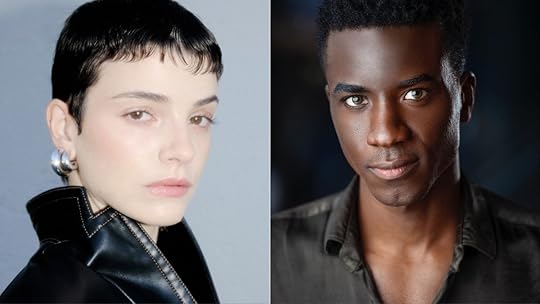 Steph Cammarano/Paradigm
Steph Cammarano/ParadigmThe series also found three additional new cadets. Kerrice Brooks (My Old Ass), Bella Shepard (Wolf Pack) and George Hawkins (Tell Me Everything) will join Diané and Steiner to play the newest cadets in the Star Trek universe.
 K. Brooks/David Muller/Yellowbelly
K. Brooks/David Muller/YellowbellyRight now, we don’t know any more about their individual characters than that. But since the series is all about “a new class of Starfleet cadets as they come of age in one of the most legendary places in the galaxy,” we bet they’ll be very important. We can’t wait to learn more about these Starfleet Academy characters soon.
Paul Giamatti Joins Starfleet Academy as the Series’ VillainPaul Giamatti has also come aboard the cast of Star Trek: Starfleet Academy. Giamatti will play Starfleet Academy‘s villain. A release shares, “Giamatti will play the season’s villain, a man with an ominous past connected to one of our cadets.” Very ominous indeed.
Every Starfleet crew has their villain. We are beyond excited to announce that Paul Giamatti has joined the cast of #StarfleetAcademy as a recurring guest star! #StarTrek pic.twitter.com/VHNWRCmYWK
— Star Trek on Paramount+ (@StarTrekOnPPlus) June 11, 2024
Giamatti will be a recurring guest star.
Star Trek: Starfleet Academy Casts Holly Hunter as Its CaptainIn an exciting turn of events, Star Trek: Starfleet Academy revealed that it has cast Holly Hunter as the captain and chancellor of Starfleet Academy. A release reiterates that, “The series will follow the adventures of a new class of Starfleet cadets as they come of age in one of the most legendary places in the galaxy.”
All cadets, rise for your captain! Academy Award winner Holly Hunter has officially been cast as the captain and chancellor of the upcoming @paramountplus series #StarfleetAcademy 🖖 pic.twitter.com/6ZLA2Kjnxk
— Star Trek on Paramount+ (@StarTrekOnPPlus) May 21, 2024
Co-showrunners Alex Kurtzman and Noga Landau share, “It feels like we’ve spent our entire lives watching Holly Hunter be a stone-cold genius. To have her extraordinary authenticity, fearlessness, sense of humor, and across the board brilliance leading the charge on STARFLEET ACADEMY is a gift to all of us, and to the enduring legacy of STAR TREK.”
Star Trek: Starfleet Academy SynopsisYou can read the official description of the new Star Trek: Starfleet Academy series right here:
Star Trek: Starfleet Academy will introduce us to a young group of cadets who come together to pursue a common dream of hope and optimism. Under the watchful and demanding eyes of their instructors, they will discover what it takes to become Starfleet officers as they navigate blossoming friendships, explosive rivalries, first loves and a new enemy that threatens both the Academy and the Federation itself.
 Paramount+
Paramount+Paramount+ also released a special “recruitment announcement” from the legendary institution itself:
Admission is now open to Starfleet Academy! Explore the galaxy! Captain your destiny! For the first time in over a century, our campus will be re-opened to admit individuals a minimum of 16 Earth years (or species equivalent) who dream of exceeding their physical, mental and spiritual limits, who value friendship, camaraderie, honor and devotion to a cause greater than themselves.
The coursework will be rigorous, the instructors among the brightest lights in their respective fields, and those accepted will live and study side-by-side with the most diverse population of students ever admitted. Today we encourage all who share our dreams, goals and values to join a new generation of visionary cadets as they take their first steps toward creating a bright future for us all. Apply today! Ex Astris, Scientia!”
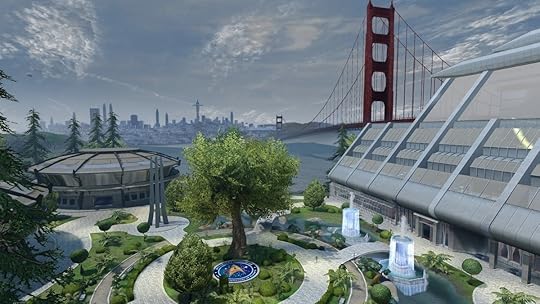 CBS/Viacom
CBS/Viacom The mention of the Academy opening up for “the first time in over a century” suggests the new Star Trek: Starfleet Academy series will be a spinoff of Discovery. We learned in recent seasons that because of a terrible galactic incident, the Federation was reduced to just a few worlds by the 32nd century. But by the end of Discovery season three, Starfleet began the climb back, and the Academy reopened.
Recently, Doug Jones seemed to confirm this, noting of a possible Star Trek return, “It would be a character by character, case by case, kind of a thing. Just as an actor in general, if I’m presented with a story I want to help tell, a character that I would really love to play, you know, it’s a case by case thing. So yeah, never say never, yes. And if Saru were to be invited back to another, let’s say Starfleet Academy, that’s the right timeline for him, he could do. I’m absolutely game to do so.”
Many fans crossed their fingers and hoped that Starfleet Academy might take place in the post-Picard timeline. We would have loved to see characters from The Next Generation, Deep Space Nine, and Voyager as instructors. But it seems more likely we’ll see characters from Discovery instead. We do also hope the new Star Trek series won’t be completely Earthbound. It would be amazing to see cadets training on starships, as we did in The Wrath of Khan.
Star Trek: Starfleet Academy Release DateSpeaking to Collider, Executive Producer Alex Kurtzman shared Starfleet Academy is “halfway through the writers room now” and preparing to film this summer. He additionally noted, “It could end up not airing until 2026. We don’t know. But by starting [shooting in late summer], just building the sets alone is a massive endeavor, then six months of shooting, then six to eight months of post.” The publication additionally notes, “While he confirmed they ‘haven’t started casting the kids,’ it sounds like some of the adult roles have already been filled.”
A recent article from Variety additionally notes that “this summer, the first Star Trek YA series, Starfleet Academy, will start production on the largest single set ever created for Star Trek on TV.” The article also describes “plans for the series’ central academic atrium, a sprawling, two-story structure that will include a mess hall, amphitheater, trees, catwalks, multiple classrooms and a striking view of the Golden Gate Bridge in a single, contiguous space. To fit it all, they plan to use every inch of Pinewood Toronto’s 45,900 square foot soundstage, the largest in Canada.” But rest assured, the article notes, there will be starships. Although since Starfleet Academy “is set in the 32nd century, an era so far into the future Kurtzman and his team need to invent much of its design language.”
Star Trek: Starfleet Academy will likely debut on Paramount+ sometime in 2024 or 2025, but we guess 2026 is also on the table.
Originally published on March 30, 2023.
The post STAR TREK: STARFLEET ACADEMY Casts More New Cadets appeared first on Nerdist.
Chris Hardwick's Blog
- Chris Hardwick's profile
- 132 followers



